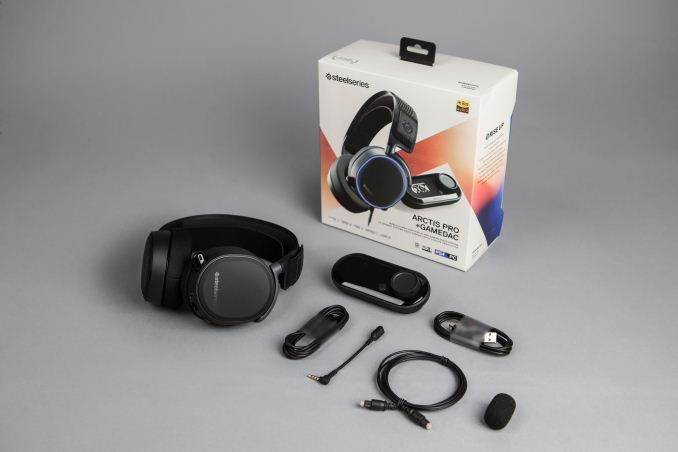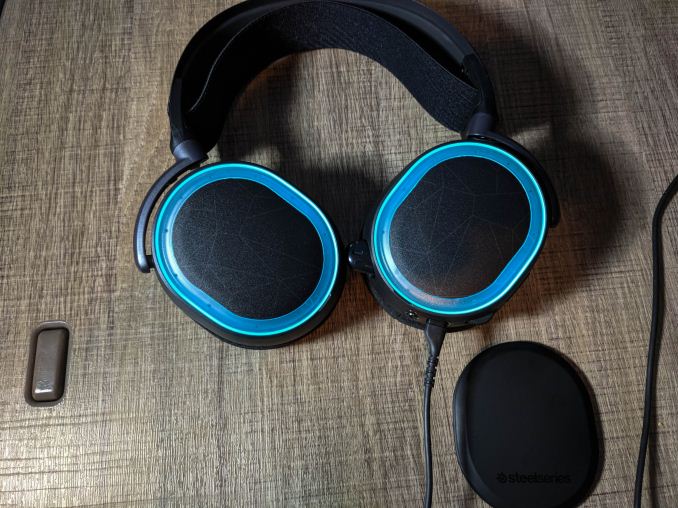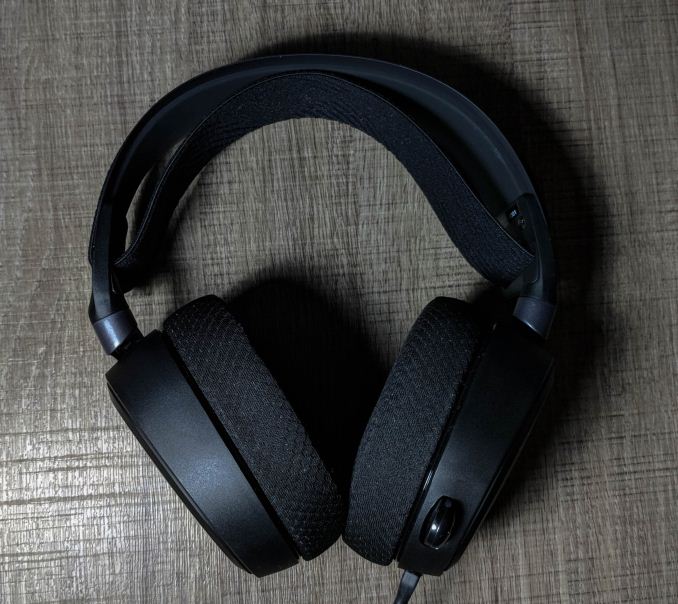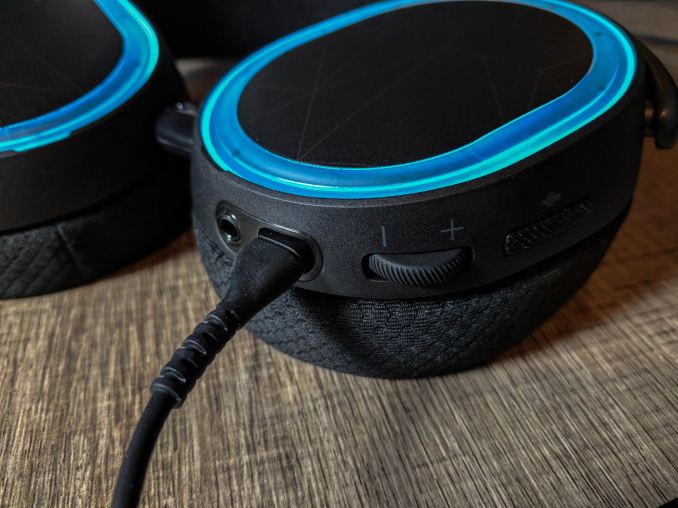The SteelSeries Arctis Pro Gaming Headset Lineup: GameDAC Or Wireless
by Brett Howse on March 13, 2018 9:00 AM EST- Posted in
- Headset
- Audio
- SteelSeries
- Accessories
- Arctis Pro
Arctis Pro Headset
If you’ve seen anything in the Arctis lineup of headsets from SteelSeries, you’ll notice right away that the Arctis Pro doesn’t go in a whole new direction in terms of styling compared to the other models in the Arctis line, and that’s not a bad thing. For those that like an understated look, Arctis definitely fits the bill. The headset is mostly black, with some gray accents on the hangers and strap, but the styling is muted, which looks great.
You can’t get an accessory anymore without some sort of RGB lighting, and the Arctis Pro features LED lighting around the outer edges of the speaker plates. The lighting, and effects, can be adjusted right in the GameDAC itself, or through the SteelSeries Engine Software, but it’s points to SteelSeries for not requiring the software to configure anything on the headset.
For those that do want a bit more edge to the styling, the speaker covers are just held on with magnets, and can easily be removed, which shows off more of the LED lighting, as well as a spiderweb design underneath. If you’d like to mix it up, SteelSeries also sells additional accessories for the headsets to customize the look a bit more.
The top strap has been slightly redesigned from the previous Arctis lineup based on customer feedback, and it features a “Ski Goggle Headband” with an adjustable strap, which lets you easily set the height the headset sits when being worn. The band provides even pressure, and overall, it’s very comfortable. The strap itself was perhaps a bit too tight when right out of the box, but a couple of weeks in and the pressure is much better.
The ear cups features “AirWeave” ear cushions, which, as the name implies, offers breathability when wearing the headset. There’s no problem with heat even after wearing them for several hours at a time. SteelSeries does offer a velour, as well as a leather ear cup, if you’d prefer that, but the AirWeave versions that come in the box are excellent.
All of the controls are on the left ear, and there’s not many since this is a wired headset. There’s a mute toggle switch, a volume knob, and the connectors. To connect to the GameDAC, the headset uses a proprietary cable which is close in size to a mini USB connector. This is in-line with the rest of the Arctis lineup, which also uses the same cable on the wired models. The cable itself is fine, but an improvement SteelSeries could have made would be to use a USB-C cable, which would be standard and easier to obtain if the original is damaged. The company does sell replacement cables on their website though, so if you do need a cable, it’s possible to get one.
The left ear cup also features a 3.5 mm input, so you could connect directly from any device, and in addition, SteelSeries ships an adapter cable from their own cable to 3.5 mm, making it very easy to hook up to a phone or other device which features a 3.5 mm jack. Here, again, USB-C would have been nice since you could also hook up to devices which have dropped the headphone jack.
Finally, there’s the bidirectional ClearCast microphone, which pulls out of the left ear cup on a flexible pole, and winds back up when not necessary. There’s a red LED on the microphone which turns on when the microphone is muted, so there’s never any doubt as to whether the microphone is enabled or not.
The build quality if the headset is very good. There’s no creaks or groans when putting the headset on, or taking it off, and features like the aluminum speaker hangers not only provide plenty of stiffness, but they keep the device weight down.
Overall, the experience with the headset has been very good, although there are a couple of small issues with the experience. First, the location of the volume and mute buttons on the back of the headset are right where your hands would naturally go when taking off or putting on the headset, so from time to time you’ll bump the buttons, which may turn on the red LED on the microphone, or raise or lower the volume.
The volume is the second point which could use some work. Unlike the volume control on the wireless model (which we’ll discuss soon) the GameDAC and headset have separate volume controls. What that means is that you can turn up the GameDAC to maximum, but you still won’t hear anything, and that’s because the volume on the headset is too low. It would be a better user experience if there was just a single volume control, especially when you bump the volume knob when removing the headset, and it can take a couple of seconds to realize why everything is so quiet. If the volume on both the GameDAC and the headset were tied together, that problem would be eliminated.
Finally, the Arctis Pro is a closed back design, which is great for isolation, but it would be nice to see an open back model as well, for those that do need to keep some connection to the real world, even if we don’t want to.














32 Comments
View All Comments
halcyon - Tuesday, March 13, 2018 - link
Sorry, but it totally reads like an advertisement. Just regurgitating basic marketing material.Real headphone reviews, read head-fi, innerfidelity, many other sites.
And the proof-reading:
"back design, when is amazing for isolation,"
Sure. I wonder if the writers get paid for just producing characters.
Dribble - Tuesday, March 13, 2018 - link
It's an advert imo. It sings the praises of a usb dac like its some sort of revelation, and not the way that most surround sound gaming headsets have been made for years.halcyon - Tuesday, March 13, 2018 - link
Also, the review states:" pretty easy to say that the Arctis Pro is one of the best gaming headsets on the market."
I doubt the reviewer has EVER tried even 1/10th of the gaming headsets on the market.
No, THIS is a proper Gaming Headset review:
https://pclab.pl/art77039-16.html
Samus - Tuesday, March 13, 2018 - link
The Steelseries Siberia is in an entirely different league than what Asus and Kingston make. Which is why the review you link too didn't even review the Siberia. For the last 4 years, the Steelseries H-series has been the benchmark to beat for gaming headphones and nobody has seemingly even tried to compete with them. Sure, the breakout boxes with OLED displays could be considered gimmicks, if they actually were gimmicks. But they are useful. Every feature in the package is useful.Brett Howse - Tuesday, March 13, 2018 - link
Not an advertisement. Of course other devices have DACs. Every audio device that hooks to a PC has a DAC.The THD+N on this GameDAC is fantastic. It has a quality amplifier built-in. It offers features that you'd not get with a normal headset.
It doesn't need ANY software installed on your PC to use it or configure it. Some companies have software that's required, and that also requires a login. And it updates every day and asks for a restart. This doesn't need any of that for the full functionality.
Not an advertisement. Just a good product.
Brett Howse - Tuesday, March 13, 2018 - link
So no, this isn't an advertisement. This is a new product, and we were able to try out the product and provide our experience with them.Originally this was going to be just a news piece for the launch, but SteelSeries got us the product several weeks ago which gave a chance to actually use them for more than the 5 minutes you'd see in a hands-on.
Just like any other product review I've done, I've used it, tested it, and provided explanations as to where I think the product excels, and where I think improvements should be made. We don't have all of the test equipment for full testing on headphones, but maybe that's something we'd look at doing in the future. Maybe not with the response this set of headphones received. If you look around, no one else even bothered to show the frequency response.
I've been looking for a set of headphones with almost all of what the Arctis Pro has to offer for some time. This lineup solves actual pain points I've had with other products. They are, in fact, very good.
Have I used every set of headphones ever? Of course not. But I've probably used several dozen.
I like quality audio. I'm not an audiophile, and I wouldn't want to be labeled as one, but if I'm looking for a set of headphones, I'd be looking for clarity, tight bass, and of course comfort, and this lineup offers all of that.
Not an advertisement. Just an experience with a product that lives up to what we were promised when discussing it with the company, and that's not always the case.
Kerdal - Tuesday, March 13, 2018 - link
Hi Brett, I was wondering something. Have you tried the Sennheiser Game One (open back) or the older PC360? I have a few of each but I'm always on the lookout for an upgrade.I'm wondering how these compare to the Sennheiser in terms of sound quality.
My motherboard is the ASUS ROG Maximus IX Code with the Sabre ES9023P and TI RC4850 amp so the gameDAC isn't all that necessary in my case.
Thanks in advance.
Brett Howse - Saturday, March 17, 2018 - link
My headset of choice is the Sennheiser HD 598 SR open back headphones. The Arctis lineup has an advantage over those though with offering better DACs so I don't have to worry about where I'm plugging in the Sennheisers.In terms of sound quality, compared to my HD 598 SRs, I would say the Arctis Pro is ahead, but the 598s are a bit more comfortable. I prefer open back though since it works better in my environment.
halcyon - Wednesday, March 14, 2018 - link
Brett, my advice, for what it is worth:1. Compare to something. Give a reference. Saying "The best" is useless, unless we know what your "best" earlier was.
2. Please try to do some semi-objective analysis of the different parts of what are the key points for a gaming headset: sound quality, sound fatigue during long term gaming sessions, wearing erconomics (headband tightness, crushing on ears, sweating), positional accuracy (using built-in 3D headphone virtualization AND/OR using the game's built-in like in Overwatch, again give us a comparison reference), microphone quality (it takes less than 5mins to fire up a recorder, record 15secs of speech, save it as 128kbps mp3, tag it into the review html).
Yes, we know you liked them, but you were mostly going ooh-aaah, about the "feature" that are basically marketing material.
We want to know how it performs. Compared to something else good.
That's why reviews are done, imho.
Brett Howse - Saturday, March 17, 2018 - link
This was going to be a first toe in the water for headphones, to get some more objective data for the future, but it might be the last.Your point 2 - I went over all those points except positional accuracy.